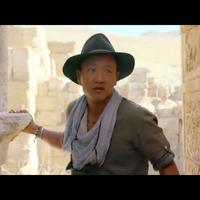Investigating an Ancient Temple | Lost Cities with Albert Lin
استكشاف||||||||
|||||Steden|||
||antico||||||
Die Erforschung eines antiken Tempels | Verlorene Städte mit Albert Lin
Investigar un templo antiguo | Ciudades perdidas con Albert Lin
Enquête sur un temple antique | Lost Cities avec Albert Lin
Indagine su un antico tempio | Città perdute con Albert Lin
アルバート・リンと古代神殿を調査|ロスト・シティーズ
고대 신전 조사하기 | 알버트 린과 함께하는 잃어버린 도시
Senovės šventyklos tyrimas | Dingę miestai su Albertu Linu
Investigando um Templo Antigo | Cidades Perdidas com Albert Lin
Исследование древнего храма | Затерянные города с Альбертом Лином
Antik Bir Tapınağı Araştırmak | Albert Lin ile Kayıp Şehirler
Дослідження стародавнього храму | Загублені міста з Альбертом Ліном
调查一座古庙|与艾伯特·林一起失落的城市
調查一座古廟|與艾伯特林一起失落的城市
[music playing]
[संगीत चल रहा है]
NARRATOR: I'm back on an ancient and Nabataean trading route.
|||||||набатейский|торговом|торговый путь
|||||قديمة||||
||||||||commerciale|
|||||||nabateia||
कथावाचक: मैं एक प्राचीन और नाबातियन व्यापारिक मार्ग पर वापस आ गया हूँ।
One that leads to the ruins of Khirbet Edh-Dharih.
||ведет к|||||Хирбет|Эд|Дхариh
||يؤدي إلى|||||||
|||||rovine||||
|||||||Khirbet|Edh|Dharih
|||||||キルベト||ダリフ
एक जो खिरबेट एध-धरिह के खंडहर की ओर जाता है।
Archeologists are still excavating this city.
|||раскапывают||
|||digging up||
|||opgraven||
os Arqueólogos|||escavando||
|||scavando||
|||発掘している||
पुरातत्वविद अभी भी इस शहर की खुदाई कर रहे हैं।
But it's clear something extraordinary
लेकिन यह स्पष्ट है कि यहाँ
was happening here.
कुछ असाधारण हो रहा था।
My guide is surveyor Ahmad Marafi.
|||землемер||
|||the||
|||il geometra||
|||o topógrafo|Ahmad|Marafi
|||測量士||
मेरे गाइड सर्वेयर अहमद मराफी हैं।
Calvin, this is the Nabataean city.
||||ナバテア|
केल्विन, यह नबातियन शहर है।
Wow.
वाह वाह।
This is the new thing.
यह नई बात है।
This a design, a layout that was created by somebody's mind
||||layout||||||
यह एक डिज़ाइन, एक लेआउट जो किसी के दिमाग द्वारा कुछ नया करने की कोशिश करने के लिए
to try something new.
बनाया गया था ।
We're going to build walls.
हम दीवारें बनाने जा रहे हैं।
Somebody's going to be over here.
कोई यहाँ आने वाला है।
And they're going to have a house over there.
||||||家|向こうに|
और वे वहाँ पर एक घर बनाने जा रहे हैं।
And then somebody is going to have a place to cook over here.
||||||||||料理する|ここで料理をする場所|
और फिर किसी के पास यहाँ पर खाना बनाने की जगह होने वाली है।
Somebody sitting in a bath house right over there.
||||bagno||||
वहीं पर नहाने के घर में कोई बैठा है।
That's true.
यह सच है।
And I'm sure they were very happy.
और मुझे यकीन है कि वे बहुत खुश थे।
This is a completely new idea.
यह बिल्कुल नया विचार है।
It seems like they were, you know, incrementally
|||||||gradually
|||||||gradualmente
|||||||徐々に
ऐसा लगता है जैसे वे थे, आप जानते हैं, धीरे-
moving forward, right.
|前に|
धीरे आगे बढ़ रहे हैं, ठीक है।
You start out as a as a nomadic society and then
|始め|||||||||
आप एक खानाबदोश समाज के रूप में शुरुआत करते हैं
and then settle.
||осесть
||stabilirsi
और फिर बस जाते हैं।
You know, that's step one.
तुम्हें पता है, यह पहला कदम है।
And then this.
और फिर यह।
There's another innovation.
एक और नवाचार है।
This city has a central focus, a temple.
इस शहर का एक केंद्रीय फोकस, एक मंदिर है।
Into the temple we go.
हम मंदिर में जाते हैं।
The Nabataean kings, they sacrificed
|набатейские|||приносили в ж
||||sacrificaram
नबातियन राजाओं ने, उन्होंने
the animals here on this altar.
|||||altare
|||||祭壇
यहाँ इस वेदी पर पशुओं की बलि दी।
Right there?
ठीक वहीं?
Yeah, right there.
हाँ, वहीं।
Walk me through the process.
मुझे प्रक्रिया के माध्यम से चलो।
I'm a Nabataean king.
मैं एक नबातियन राजा हूं।
I stand here in front of this altar.
मैं यहाँ इस वेदी के सामने खड़ा हूँ।
What happens next?
आगे क्या होता है?
First, you have to walk around the holy place.
|||||||sacro|
सबसे पहले, आपको पवित्र स्थान के चारों ओर घूमना होगा।
[music playing]
[संगीत चल रहा है]
Up here now?
|aquí|
अब यहाँ ऊपर?
Yeah, up.
हाँ, ऊपर।
So we are now on the altar.
||||||altare
इसलिए अब हम वेदी पर हैं।
So you lay your animal here.
तो तुम अपने जानवर को यहाँ रख दो।
Then what happens?
फिर क्या होता है?
Cut the throat to let the blood,
इन छिद्रों के अंदर
which goes inside these holes.
||||agujeros
जाने वाले खून को जाने देने के लिए गला काट दें ।
These little holes, these are blood holes?
ये छोटे छेद, ये खून के छेद हैं?
Yeah, these are blood holes.
हाँ, ये खून के छेद हैं।
Blood spilled from animals, went down these holes.
|versato||||||
जानवरों का खून गिरा, इन गड्ढों में चला गया।
That's true.
यह सच है।
NARRATOR: The statues I scanned at the museum
||||スキャンした|||
कथावाचक: संग्रहालय में मैंने जिन मूर्तियों को स्कैन किया था, वे
once adorned the facade of this temple.
|украшал|||||
|decorated||front exterior|||
|ornava||facciata|||
|adornada||fachada|||
एक बार इस मंदिर के अग्रभाग को सुशोभित करती थीं ।
To create a complete vision of this new Nabataean sight
इस नई नबातियन दृष्टि की पूरी दृष्टि बनाने के
requires a full digital scan.
लिए एक पूर्ण डिजिटल स्कैन की आवश्यकता है।
It's the first time this has ever been done.
ऐसा पहली बार किया गया है।
It's a complex undertaking, demanding detailed scanning
|||compito complesso|richiede||
यह एक जटिल उपक्रम है, जिसमें हवा और जमीन से विस्तृत स्कैनिंग की मांग
from the air and on the ground.
की जाती है। डेटा को मिलाने
Merging the data creates a new vision
Объединение||||||
マージング||||||
A fusão||||||
Unire||||||
से इस शानदार लंबे समय से खोए हुए मंदिर की
of this spectacular long lost temple.
||захватывающий|||
एक नई दृष्टि पैदा होती है ।
Crowning the temple are the museum relics,
венчают||||||
||||||as relíquias
頂点に||||||
Culminación||||||
Sormontano||||||reliquie
मंदिर का मुकुट संग्रहालय के अवशेष हैं,
back in their original home.
जो अपने मूल घर में हैं।
This place reveals the evolution from their starter city
||показывает||||||
||示す||||||
|||||||città iniziale|
यह स्थान सेला में उनके प्रारंभिक शहर से विकास को प्रकट करता है
at Sela.
|Sela
।
[music playing]
[संगीत बजाना]

